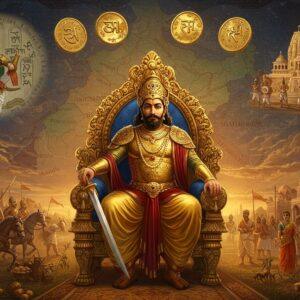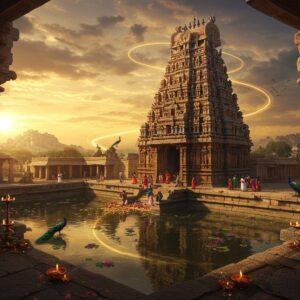
The Dashavatara Temple in Deogarh, Uttar Pradesh, stands as a testament to India’s glorious past. Nestled about 125 kilometers from Jhansi in the serene Betwa River valley, this temple is an emblem of early Hindu stone architecture. Built around 500 CE, it offers a glimpse into the Gupta period’s artistic prowess.
Historical Context
Constructed during the Gupta Empire’s zenith in the late 5th century CE, the temple reflects the era’s cultural richness. This period, known as the Golden Age of India, witnessed remarkable progress in art, architecture, and literature. The Dashavatara Temple is pivotal in understanding the evolution of Hindu temple architecture and its role in spreading Vaishnavism.
Architectural Features
The temple’s design is a feast for the eyes. It showcases the Nagara style with a simple square plan and a pyramidal shikhara. The Panchayatana layout, featuring a central shrine surrounded by four smaller ones, represents a cosmic mandala. Intricately carved panels adorn its four entrances, depicting tales from Hindu mythology, including scenes from the Ramayana, Mahabharata, and Vishnu Purana.
Significance and Symbolism
Dedicated to Vishnu, the Dashavatara Temple holds profound spiritual meaning. The ten incarnations of Vishnu, or Dashavatara, symbolize divine interventions to restore cosmic balance. These legends are vividly sculpted on the temple walls, offering insights into ancient rituals and spiritual practices. The temple also houses images of other deities like Shiva, Parvati, Kartikeya, Brahma, Indra, and the river goddesses Ganga and Yamuna, showcasing the rich tapestry of Hindu deities.
Cultural and Religious Impact
This temple has significantly influenced India’s cultural and religious tapestry. Its architectural innovations paved the way for future temple designs. As a pilgrimage site, it continues to inspire devotion and reverence among worshippers, preserving India’s intangible heritage. The temple was rediscovered in 1871 and is considered India’s oldest surviving Panchayatana temple.
Preservation and Conservation Efforts
Safeguarding this ancient monument is crucial. The Archaeological Survey of India leads initiatives to maintain its structural integrity and artistic legacy. Community involvement and sustainable tourism play vital roles in ensuring its preservation for future generations. These efforts help protect not only the physical structure but also the rich history and stories embedded within the temple walls.
Visiting the Dashavatara Temple
Plan your visit to the Dashavatara Temple to experience its historical grandeur. It’s best visited during cooler months. Deogarh offers routes easily accessible from Jhansi, approximately 125 kilometers away. Nearby attractions like the Deogarh Fort and Jain temples, located about 500 meters from the temple, enrich your journey, promising a deep connection with India’s sacred history. The temple’s location below the Deogarh hill, near the river, adds to the serene and spiritual atmosphere.
The Dashavatara Temple is more than just a historical site; it’s a living chapter of India’s spiritual saga. Its stories, etched in stone, continue to captivate those who seek to understand the depth of India’s cultural heritage.
How Poojn.in Supports Your Temple Visit and Worship
Poojn.in offers essential items needed for worship at the Dashavatara Temple in Deogarh. As India’s largest cultural goods and services store, we provide:
- Complete puja samagri kits specifically curated for Vishnu worship, ensuring you have everything needed for a fulfilling prayer experience.
- Pure copper and brass items for temple offerings, adding a touch of traditional authenticity to your worship.
- Traditional dhoop and agarbatti made with natural ingredients, creating a sacred atmosphere with their fragrant smoke.
Our products help maintain the authenticity of your temple rituals while offering the convenience of online shopping. We carefully source items from verified vendors who follow traditional manufacturing methods. All products come with detailed usage instructions in multiple languages.
For temple visits, we recommend our Temple Visit Kit which includes:
- Flowers and garlands, adding a touch of beauty and devotion to your offering. These are carefully selected and packaged to ensure freshness.
- Coconut and fruits for prasad, a traditional offering that symbolizes gratitude and blessings.
- Camphor and incense sticks, purifying the air and creating a sacred ambiance.
Visit www.poojn.in to explore our complete range of authentic puja items. We offer pan-India delivery with secure packaging to preserve the sanctity of religious items.
Embracing the Legacy of Dashavatara Temple
As you stand before the Dashavatara Temple, feel the whispers of ancient stories and the power of divine art. This temple is not just a relic of time; it is a journey into India’s rich past. Each carved stone speaks of devotion, artistry, and the enduring spirit of our heritage. By visiting, you honor the guardians of our culture and ensure that these timeless tales continue to inspire future generations. Let the Dashavatara Temple remind us of the beauty and wisdom embedded in our traditions, inviting us to cherish and preserve them with reverence and pride.
FAQs about Deogarh’s Dashavatara Temple
What is the historical significance of the Dashavatara Temple? The Dashavatara Temple holds immense historical significance as one of the earliest surviving Hindu stone temples. Dating back to the Gupta period (around 500 CE), it provides valuable insights into the art, architecture, and religious practices of that era. Its intricate carvings offer a glimpse into the mythology and beliefs prevalent during the Gupta Empire.
What makes the architecture of the Dashavatara Temple unique? The temple’s architecture is a unique blend of the early Nagara style and intricate sculptural ornamentation. The panchayatana layout, with its five shrines arranged around a central structure, is a distinctive feature. The detailed carvings depicting scenes from Hindu epics, including the ten incarnations of Vishnu, add to its architectural richness. The temple’s pyramidal shikhara is a precursor to later North Indian temple styles.
Is the Dashavatara Temple easily accessible for visitors? Yes, the temple is accessible by road. Located in Deogarh, in the Lalitpur district of Uttar Pradesh, India, it’s about 125 kilometers from Jhansi. Visitors can check local travel advisories and plan their journey accordingly. Public and private transportation options are usually available. It’s advisable to wear comfortable shoes as the temple complex may involve some walking.
Krishna’s Flute: Symbolism of Music, Divinity, and Devotion
Krishna’s Ten Avatars (Dashavatara) Explained: Krishna’s Significance
Create a Krishna Altar: A Simple Guide for Your Home


